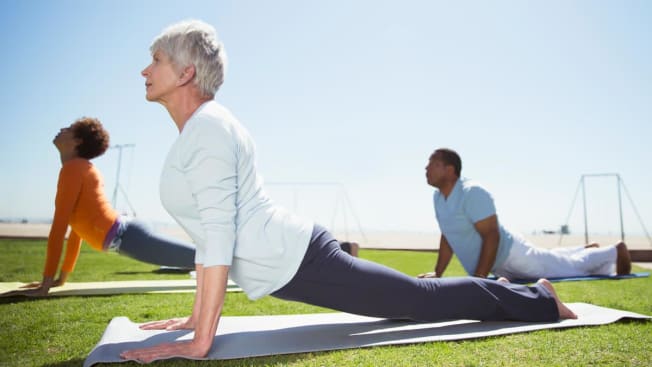Experts spell out the rewards of this mind and body practice, plus two beginner poses

Yoga may help with chronic pain and mobility. Restorative yoga, which uses props, can make each pose more accessible for beginners.
By Lindsey Konkel
Yoga, which blends movements and poses with deep breathing and meditation, has many potential health benefits, including better balance and stress relief. It’s generally considered safe, but injuries can occur.
A review published in 2018 found that a considerable portion of yoga practitioners have had yoga-related injuries, many of them musculoskeletal, involving muscles, bones, joints, tendons, ligaments, and cartilage. (It’s worthwhile to consider yoga mats for extra cushioning for your sessions, especially if you have certain kinds of back pain or find it difficult to lie on the ground.)
A few simple steps can help you figure out where to begin and how to avoid some common injuries.
Benefits of Yoga
Yoga could help some people manage chronic pain and maintain mobility. Although a 2022 Cochrane review of 21 clinical trials found that it may offer little benefit for back-related function and pain, researchers did find that yoga may have some benefit in helping improve one’s ability to be active. And compared with other exercises, yoga may have an effect similar to other back-focused exercises in improving back-related function.
“If you don’t use it, you lose it,” says Michael Wasserman, MD, a geriatrician and the chair of the public policy committee at the California Association of Long Term Care Medicine. Yoga has been shown to reduce the risk of falling for older adults with dementia, stroke, or multiple sclerosis.
Yoga may help alleviate discomfort by improving flexibility and building muscle and core strength, Wasserman says. Deep breathing could contribute, too.
“Controlled breathing has been used as a pain-control measure for centuries,” says Carol Krucoff, a yoga therapist at Duke Integrative Medicine in Durham, N.C.
How to Get Started With Yoga
Beginners may do best to look for classes described as restorative, gentle, or Iyengar, says Jessica Matthews, DBH, a professor of kinesiology and integrative wellness at Point Loma Nazarene University in San Diego. These classes use props such as blankets and bolsters to make poses more accessible. “Let your instructor know if you have any special needs or health considerations, such as arthritis,” she says. That way, they can show you modifications to poses.
If you have balance or mobility problems, chair yoga, done while sitting or using a chair for support, may be a good option, says Juyoung Park, PhD, a professor of social work who studies the benefits of yoga at Florida Atlantic University in Boca Raton.
The International Association of Yoga Therapists or Yoga Alliance can help you find instructors experienced in gentle or restorative yoga. And don’t overdo it. “People get injured in yoga when they push themselves too hard,” Krucoff says. “A yoga pose should feel steady and comfortable, not strained.”
Two Poses to Try
1. Belly breathing, an easy way to relax and reduce stress.
- Lie down or sit tall in a chair.
- Place your hands on your lower abdomen, beneath the navel. Relax.
- Breathe in through your nose, filling your lungs completely. Your belly will round and push gently against your hands. Avoid straining.
- Breathe out slowly through your nose. Repeat for five to 10 breaths.
2. Tree pose, which can help improve balance and core strength.
- Stand with your feet hip-width apart.
- Focus your gaze on a spot at eye level. Pick up your left heel, bend your left knee, and turn your left leg slightly outward.
- Slide the sole of your left foot against your right ankle, leaving the ball of your left foot touching the ground.
- Bring palms together in front of your chest or lightly touch a wall, countertop, or chair back.
- Balance here for three to five breaths.
- Repeat on the other side.
Need a Yoga Mat?
If you’re interested in getting started with yoga and are looking for a mat to practice on, check our evaluation of 17 yoga and exercise mats.
Editor’s Note: An earlier version of this article appeared in the May 2018 issue of Consumer Reports On Health.
Consumer Reports is an independent, nonprofit organization that works side by side with consumers to create a fairer, safer, and healthier world. CR does not endorse products or services, and does not accept advertising. Copyright © 2024, Consumer Reports, Inc.









